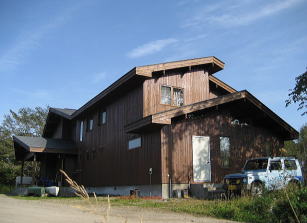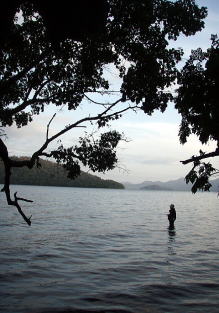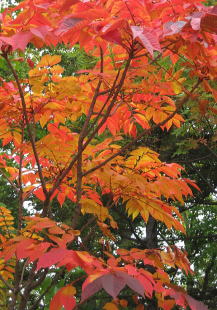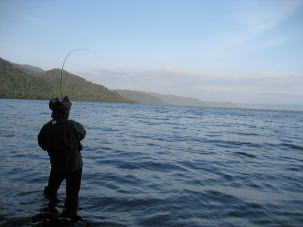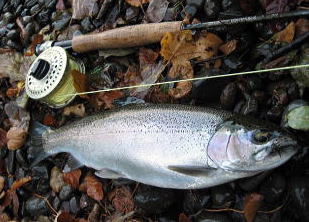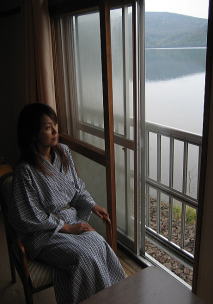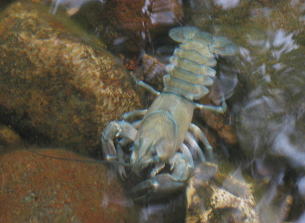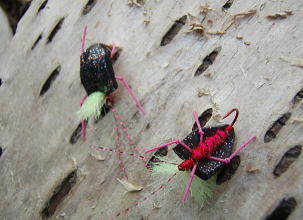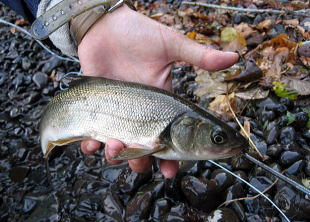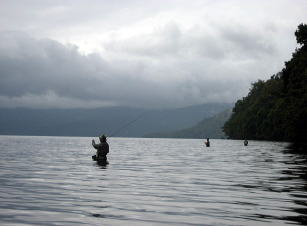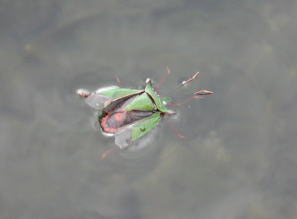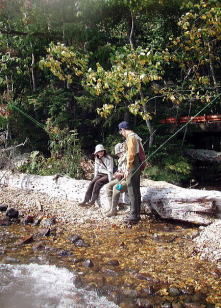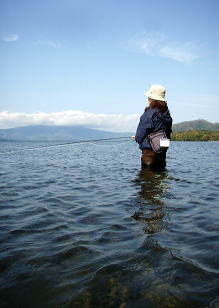Later in the afternoon, the gale lulled to a tolerable level. We went back
to the western shore. The lakebed here is mixed with sands and rocks, and
is nicely steep to lure even the weary fish to the buggy shallows. Quite
suiting my strategy, I saw vast number of cast away insects foaming a scum
line.
And sure enough, I saw a bulging rise some 5meters off from the shore.
I presented my trusty kamemushi fly and waited in a quiet anticipation.
Counting 5 or maybe 10, my pretty kammy disappeared. Bingo!!
Again we put up at Masuya (the trout inn),
right by the Kushiro river.
The owner is an avid flyfisher himself, and the dinner his wife beautifully
prepares is something all the guests look forward to.
There are validated records of trophy trout reaching whopping 80cm. Such
news calls up all the trout fishermen across the nation, but standing in
front of the huge expanse of water, you might feel a bit lost. Well, we
did.
One things that has become known lately is the important role the beetles
are playing in the food chain, with the biggest and perhaps the spiciest
being kamemushi, or stink bugs. When provoked they discharge stinking fluid.
Why, my beloved finny beauties, of all the insects in the world, oh, why
do you have to!?
As the cold front passed over the region, the lake received strong easterly
winds.
We moved to the eastern side of the lake to dodge the rough waves. Here
we found the lake very flat with featureless sandy floor. Few sign of life,
during the day anyhow.
The first day was cloudy and looked promising. On the surface we saw hundreds
of hapless insects floating by. But there're few signs of fish in the shallows,
perhaps due to the warm water temperature still at 18c.
Next day dawned in a blue sky and a nice morning chill. A quick lake side
conference and off we went in pursuit of our elusive foes.
Kamemushi beetles in Hokkaido has bright red abdomen that only adds to
the repugnance even as I tie their lifelike imitations.
We seriously worried what if they fly around us or even touch down on us.
And sure enough, we ended up serving the role of an aircraft carrier on
behalf of these clumsy fliers. Need a zen state of mind I tell you.
Our next destination was lake Kussharo, 2 hours' drive west. There we joined
two fishing friends of ours, to together chase the rainbow.
The lake lies in a cavity made by a volcanic eruption and, with a circumference of 57km, it's the largest of the kind in our country. There are still sporadic geo-thermal activities and the lake was annihilated by toxic sulfur once in 1938. Only after half a century's self-purification and with the great effort of local fishermen, recovered the lake to the trout fishery that it is today.
For three days we fished the lake on and off, landing 5 rainbows between
40-43cm. Not a catch worth writing home about, but the restlessness we
sensed in the crisp autumn air was very special, even sweet.
It gets quickly dark this time of the year. We wished if we could stay
on, watching the silhouette of the fly just a little bit longer.
- H'kaido in autumn - 3
Another fish that fancy surface meals - a Hokkaido variety of barbel.
In lake fishing where the biggest enemy being boredom, we welcome any action,
or even distraction.
Another place we stayed was this age-old spa house right on the lake. The
heaved Tatami mattress and the squeaking aluminum sash, plus that pre-historic
14inch micro TV all make up that nostalgic old inn atmosphere.
But above all, that big bath tub carpeted with pebbles (photo in our summer
trip report) is something we can't afford to miss.
'Kussharoko Nibushi Hoyo-jo',
Tel. 01548-3-3058

'06 H'kaido in Autumn - 2Leaves turning into autumn colours.
We could even spot odd squirrels busy squirreling nuts for the winter.
Wasn't exactly a monster as they flaunt in a magazine cover, but still
a nice fish with a shiny torpedo body.
This and other fish that we caught later ran well but did not jump at all,
which I find strange for the happy jumpers. But in their defense, they
were in the middle of an all-U-can eat insects buffet and not in a mood
to play an aerial dance perhaps. Oh No, don't dare ask what's in that happy
tummy!!
On the bottom of glass clear water you may see something moving - crawfish.
They were introduced from North America in the pre-war era as a protein
source for the ill-fed frontier settlers. They adapted well to the cold
Hokkaido climate and are today thriving in many of the northern lakes -
though at the sacrifice of our native, smaller crawfish.
They never gained much popularity on the dinner table, but perhaps more
palatable to the tastebuds of big trout in the nutrient-poor cold water?
